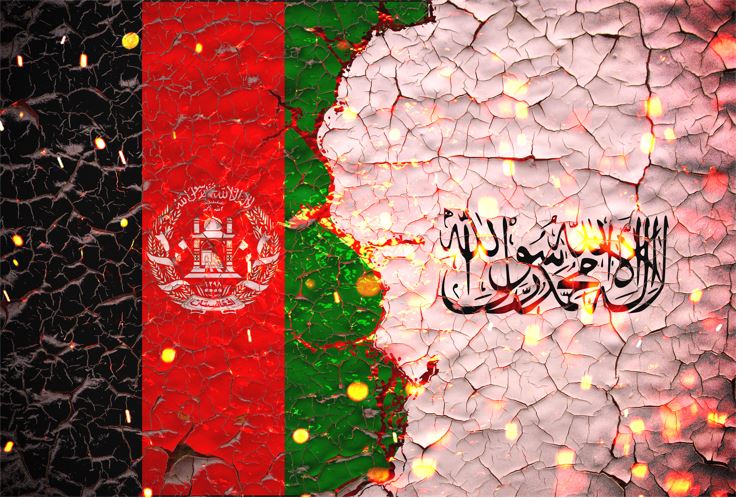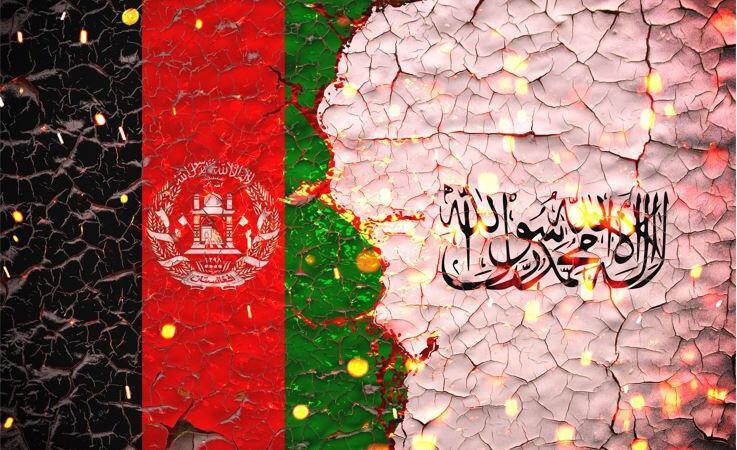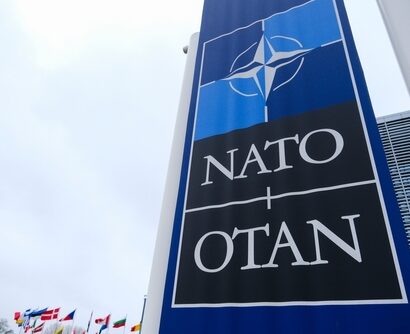Abstract: In August 2021, the Taliban’s blitzkrieg across Afghanistan led to an ignominious withdrawal of American and NATO troops, toppling the democratically elected Afghan government. The Taliban’s victory raises serious questions about the geopolitical balance of this region. For example, countries like Pakistan and China want to seize this opportunity to expand their strategic influence in this region; whereas Western countries are concerned that Afghanistan will once again become the hinterland for al-Qaida and other extremist groups. This report aims to revisit the history of the Afghanistan crisis and the events leading to the Taliban’s triumph in Afghanistan; in addition to the potential geopolitical impact of the crisis.
Bottom-line-up-front: The Taliban’s victory would certainly choke the dreams of Afghan democracy for the foreseeable future, boosting the morale of non-state actors operating in the region. The volatile situation in Afghanistan will continue to send shock waves throughout the world, while some countries aim to exploit the situation, while others may be at a loss.
Problem statement: How to understand the events leading to the existing Afghanistan quagmire and its regional and international implications?
So what?: The international community must come together to form a comprehensive strategy to deal with the Afghanistan situation. Thereby ensuring that the individual interests of countries would not hinder the prospect of a peaceful and stable Afghanistan. Otherwise, we may see a repeat of the Iraq-Syria catastrophe in this part of the world as well.

Source: shutterstock.com/sameer madhukar chogale
Prelude
In the aftermath of the World Trade Centre attack on 11th September 2001, America called on the Taliban regime of Afghanistan to deliver Osama bin-Laden and his al-Qaida associates (the mastermind behind 9/11), hiding in Afghanistan or “share in their fate.”[1] While the Taliban demanded credible proof of bin-Laden’s involvement in the attack,[2] on 7th October, the American military, supported by the British, began a bombing campaign over Afghanistan, soon accompanied by the conventional ground forces of American allies and Afghanistan anti-Taliban factions – Operation Enduring Freedom was now in effect.[3]
The Taliban’s strongholds rapidly started to crumble, and by November 2001, they were a spent force. During their waning days, the Taliban tried to lobby through Hamid Karzai, soon to be Afghanistan’s interim President, for a cease-fire. The United States, however, rejected any negotiations as they were confident that any action would result in the complete defeat of the Taliban.[4] After the Taliban collapse in 2002, the U.S. announced the rebuild-Afghanistan initiative. The Taliban, in response, used insurgency to destabilise the Western ambitions for Afghanistan.
Two decades later, in an insurgency-infested Afghanistan, power has tilted in the Taliban’s favour, bringing America to the negotiations table in 2020. A deal that will not only mark an end to American presence in Afghanistan but a rapid advancement of the Taliban back into power. Against the backdrop of an ignominious American withdrawal and against all the predictions, the Taliban took over Kabul on 15th August 2021, followed by thousands of Afghans mobbing the Kabul airport to flee the Taliban’s feared hardliner brand of Islamic rule. So, after spending close to 2 trillion U.S. dollars, a loss of 2,455 US service members and Afghanistan’s civilian casualty well over 46,000, the pertinent question is – was it worth it?[5]
In a televised speech from The White House on 17th August 2021, President Joe Biden hailed the longest American war’s Afghanistan campaign as a success claiming the U.S. counterterrorism mission is complete. He also criticised the Kabul government and the Afghan security forces for failing to counter the Taliban. However, the U.S. counterterrorism operation – the Global War on Terror – which zeroed in on Al-Qaeda sanctuaries in Afghanistan in 2001, is far from being over.
A June 2021 United Nations (U.N.) report claims that the Taliban and al-Qaida remain closely aligned and show no signs of breaking ties. Dr. Sajjan Gohel from the Asia Pacific Foundation asserts that around 200-500 al-Qaida members are active in the Kunar province of Afghanistan, and these figures are set to increase. Besides al-Qaida, a new adversary, Islamic State Khurasan (ISK) – part of the affiliate array of the murderous group Islamic State – has been active in Afghanistan since 2015, and it snubbed President Biden’s claim by carrying out the deadly suicide bombings at the Kabul Airport on 27th August 2020. So not only the United States failed to defeat the Taliban, but it also failed to establish a functional democracy in Afghanistan despite the colossal cost of human lives and resources. America could not thwart the spread of Islamic extremism and failed even to leave on its own terms. The Taliban’s argument is simple: we are back in power, and the Islamic Emirate of Afghanistan is restored. Before considering the implications of the Taliban’s Afghan victory, it is worth exploring the US-Taliban “peace deal” that paved the way towards the American unconditional withdrawal.
So not only the United States failed to defeat the Taliban, but it also failed to establish a functional democracy in Afghanistan despite the colossal cost of human lives and resources.
The Peace-Process
The Afghan Peace Process included the U.S., the Taliban and the Afghan government as the main parties. China, Russia, India and North Atlantic Treaty Organisation (NATO) Member States also played facilitating roles. The negotiations extended back to the beginning of the insurgency and produced two peace treaties: the first on 22nd September 2016 between the Afghan government and the Hezb-i Islamic Gulbuddin Group, and the second on 29th February 2020 between the U.S. and the Taliban.
Negotiations began in December 2001 with the Bonn Agreement, seeing the U.S. exclude the Taliban from initial talks – which is frequently cited as an explanation for the Taliban’s return to violence.[6] In the shadows of the Iraq war, the Taliban were rebuilding and launched an insurgency campaign. The United States government viewed Afghanistan as being in “serious danger” of falling to the Taliban by 2007.[7] Despite a consensus within Afghanistan that the war should end, the Taliban rejected peace talks in the mid to late 2010s with the Afghan government, viewing it as an American puppet.[8]Tensions were heightened by then U.S. President Barack Obama’s increase in troop deployment.[9] To ease tensions, in January 2010, Karzai wanted to reach out to the Taliban. This aligned with a change in the heart within the Obama administration. Now, possible political negotiations were beginning to be considered.[10] Akin, during 2011, the U.S. held secret talks with the Taliban, but these were repeatedly cancelled due to disputes between the Afghan government and the Taliban.[11] In 2018, the new Afghan President, Ashraf Ghani proposed further talks, offering the Taliban legal-political recognition and a prisoner exchange. This was the most favourable offer presented to the Taliban since 2001.[12] As a result, the Taliban and Ghani’s government agreed to a ceasefire during the Eid al-Fitr celebrations in June 2018, but fighting quickly resumed after the festivities. Talks continued into 2019, culminating in a draft agreement produced in Qatar in February. At the eight-round of U.S.-Taliban talks in August, the two powers were close to reaching a deal. The deal was ultimately undermined less than a week later due to a terrorist attack in Kabul.[13] Again, once tensions fell, negotiations resumed in December 2019. On 29th February 2020, the Taliban and the U.S. finally signed a peace agreement in Qatar, titled the Agreement for Bringing Peace to Afghanistan, which included the withdrawal of all U.S. and NATO troops; the prevention of al-Qaida from operating in Taliban-controlled areas; and the resumption of talks between the Taliban and the Afghan government. The Afghan government was not a party in the deal due to continued disputes over prisoner exchanges which would continue to cause significant issues for the remainder of the peace process. Despite the conditions of the agreement, insurgent attacks increased significantly thereafter. By November 2020, civilian casualties were the highest since U.N. records began in 2009.[14]
Talks continued into 2019, culminating in a draft agreement produced in Qatar in February. At the eight-round of U.S.-Taliban talks in August, the two powers were close to reaching a deal.
By late August/early September 2021, the Taliban had resumed power in Afghanistan, seeing a chilling reality when reflecting on the U.S. ambassador to Afghanistan’s warning that an agreement could result in the Taliban reclaiming power – likening it to the aftermath of the Paris Peace Accords following the Vietnam War.[15] Despite these warnings, President Biden announced that all U.S. military forces would leave Afghanistan by September 2021.[16] The Taliban capitalized on the emerging security vacuum and continued their offensive in the summer of 2021, claiming over ten provinces by 16th August 2021. On the 15th August 2021, the Taliban entered the capital of Afghanistan, Kabul, forcing Afghani President Ghani to flee and the remaining government to collapse. The Taliban then announced their entrance into the presidential palace and taking of the city. While these negotiations were intended to bring peace to Afghanistan, having the Taliban in control presents an unnerving situation, both for Afghan civilians and the international community.
The Geopolitical Impact
The current situation in Afghanistan already has and will continue to send shockwaves through the international community as the power within the country continues to change and develop. Some countries are being impacted positively, while others remain uncertain about the power shift in Afghanistan.
India is facing tense diplomatic relations with the Taliban and a potential loss of influence in the region due to their position with Pakistan and tensions that have occurred in the past over Afghanistan sheltering of anti-India – Lashkar-e-Taiba, terrorists (established on the Afghan soil in 1987), the last time the Taliban was in power.[17] The Indian government had a cordial relationship with Kabul (before its fall) and invested heavily in infrastructure and reconstruction projects, also providing aid worth over $3 billion.[18] However, while countries such as the USA have an ‘exit’ in the sense that they are geographically removed from the situation in Afghanistan, India has no such luxury. Likely, India will be the last country in the region to accept the Taliban regime as a legitimate power, and thus a new relationship will emerge. The new relationship is expected to be less cohesive than it was with the pre-Taliban government. However, given that the Indian government still has economic interests in the country, it is expected that financial support and investment is likely to continue, even if diplomatic relationships are stalling.
Both Russia and China seek to keep diplomatic relations with the Taliban, although they are both doing so for different reasons. China has already sought to develop diplomatic ties with the Taliban. For example, China kept its embassy open in Kabul when many others closed. The Chinese government is developing this relationship to ensure that terrorists seeking to disrupt operations in Xinjiang are not allowed a safe haven in northern Afghanistan[19] and to ensure that the Chinese Belt and Road initiative (the BRI) is not disrupted.[20] Economic investments such as this initiative cannot flourish in a country or area that is unstable, as changing governments and war negatively affect the country’s economy.[21] Central Asia needs to be relatively stable for the BRI to succeed, as the Belt and Road runs straight through it. China will likely seek to exert its influence over Afghanistan in a more dominant manner to ensure its economic interests will not be disrupted.
The Chinese government is developing this relationship to ensure that terrorists seeking to disrupt operations in Xinjiang are not allowed a safe haven in northern Afghanistan and to ensure that the Chinese Belt and Road initiative is not disrupted.
Russian interests would be disrupted if the neighbouring central Asian states such as Tajikistan and Uzbekistan became affected by instability spilling over from Afghanistan into their borders.[22] As a result, Russia is operating similarly to China, also doing so to secure stability in the region.
While India is expected to suffer under the new Taliban regime, Russia and China expect not to suffer outside of possible tensions arising from vying for more influence in the region. Pakistan is likely to benefit from the rise of the Taliban to power.[23] Two decades ago, when the Taliban held control of the majority of the country, Pakistan was one of the only governments that recognised the Taliban as a legitimate government.[24] This acknowledgement created a certain level of goodwill between the two nations, which means that Afghanistan’s new power is somewhat pliable to the will of Pakistan; if the Taliban is ever to listen to an outside power or state, it may well be Pakistan. Pakistan creating an alliance with the Taliban only helps to further its influence in the region, providing it with a strategic defence against its rival, India. While their influence in the region may grow through their developing alliance, it is not expected to last. The relationship between the two actors may provide an opportunity through which Pakistan may increase certain aspects of their regional power. However, a realist would suggest that this relationship may be one less of generosity and solely being used to increase Pakistan’s influence, and more so to increase the influence of the Taliban, which in turn increases instability in the region, providing other opportunities for regional actors to take advantage of. Now that it is in power, the Taliban may decide to differ in who they make firm alliances with, diversifying their repertoire, and Pakistan may be left behind. Even though Pakistan’s government and the Taliban have shared various ideological similarities in the past, there are many differences. While the Taliban are unpredictable, they are expected only to continue alliances with those who share and respect the ideologies the Taliban espouse; if not all their doctrines and actions are the same, will they continue to align themselves with countries such as Pakistan? Notably, the threat from Tehrik-e-Taliban Pakistan (TTP), which has bases in Eastern Afghanistan and has launched several high-profile attacks in Pakistan and is now more aligned with the nationalist agenda of the Taliban. Yet despite this uncertainty, Pakistan does currently see itself as the foremost geopolitical winner of the Afghan situation.
It is undeniable that there will be global geopolitical impacts from the conflict in Afghanistan and the rise of an unstable power. There will be an increase in transnational drug trafficking originating from Afghanistan. The withdrawal of foreign troops who were previously keeping the growth of poppy seeds in check has resulted in farmers being given permission from the Taliban forces to plant poppy seeds, which once processed is used to create the illicit drug heroin. Come harvest time in Afghanistan, there will be an influx of heroin hitting the global market. Given the current drug epidemic in the United States, of which heroin is a vital cause, this particular effect is of the utmost importance given its international repercussions.
As well as this, an obvious but still mentionable outcome will be the fact that there will be an increase in terrorism globally. The rise of terrorism has many possible forms it can take now the Taliban has risen to power and facilitated an environment through which terrorist activity can grow. Terrorists may be sheltered in Afghanistan, or they may be educated in all things terrorism in Afghanistan before returning to their home countries. There may be an influx of terrorist ideologies spreading over the internet (originating in Afghanistan), or there may simply be an increase in the number of terror attacks in Afghanistan. There will be a global growth of terrorism and many more will suffer as a result.
The withdrawal of foreign troops who were previously keeping the growth of poppy seeds in check has resulted in farmers being given permission from the Taliban forces to plant poppy seeds, which once processed is used to create the illicit drug heroin.
The Taliban’s swift return to power has left both neighbouring countries and the broader global community fearful of a changing geopolitical outlook[25], as well as regional instability that could spill out of the country, slowly spreading the aforementioned negative impacts further afield.
Conclusion
Since the Taliban took over Kabul and the chaos that followed, the Taliban have repeatedly said that they should not be judged based on their 90’s ultra-hardliner avatar. The “new” Taliban will be more tolerant and lenient towards women and non-Taliban factions.[26] However, there are four critical uncertainties related to the Taliban rhetoric.
First, what will the new Afghan government look like and its composition? A few credible sources have claimed that Mullah Baradar – A co-founder and the head of the Taliban’s political office, will lead the new government. Mullah Mohammed Yaqoob (the deputy head of the Taliban’s political office) and Sher Mohammad Abbas Stanekzai (a senior negotiator for the Taliban), are set to take high-ranking positions in the government.[27] Initial comments from Abbas Stanekzai were not very encouraging when he said that the new government would not include officials from the previous government and women will not hold senior positions.[28] The question is not about how many women or non-Taliban officials will be included in the government, but what roles they will hold and their influence level in the new government. It will be a vital assessment of the Taliban’s claim of an all-encompassing Afghanistan.
Secondly, there is a big question mark over the Taliban’s relationship with the Salafi-Jihadist groups – especially al-Qaida. As discussed earlier, several reports have claimed that since being ousted from power in 2001 to their revival in 2021, the Taliban have maintained close contact with al-Qaida. The European intelligence community has expressed grave concerns that Afghanistan will yet again become a breeding ground for the extremists.
The Taliban’s closest ally Pakistan, which harboured bin-Laden in Abbottabad (2011) and has been using a terrorist proxy network in Kashmir since the ‘90s, may tilize the Afghan soil for anti-India activities. The United States may employ airstrikes (from its Middle Eastern bases) to deter any terrorist threat posed by al-Qaeda, Islamic State(K) in Afghanistan. However, this may not include the South Asian jihadists groups such as the Pakistani Taliban and Lashkar-e-Taiba – overall enduring the regional terrorism threat.[29]
Lastly, the domestic anti-Taliban resistance, the National Resistance Front (NRF) in the Panjshir valley of Afghanistan. The NRF, under the leadership of Ahmad Massoud and made up of thousands of anti-Taliban militia and former Afghan security forces, is all that currently stands in the way of the Taliban exerting absolute control over Afghanistan. Although Ahmed Massoud has offered peace talks with the Taliban, the latter is less keen on negotiations. Meanwhile, heavy fighting continues in the rugged valley of Panjshir.[30] In the long run, the NRF can potentially debunk the Taliban’s sovereignty claim over Afghanistan. Ahmad Massoud has blamed[31] the Pakistani forces and their intelligence agency- ISI, for spearheading the Taliban’s offensive in the Panjshir, which as of 6th September 2021 allegedly has fallen to the Taliban. NRF has refuted this claim.
The NRF, under the leadership of Ahmad Massoud and made up of thousands of anti-Taliban militia and former Afghan security forces, is all that currently stands in the way of the Taliban exerting absolute control over Afghanistan.
Overall, it is still early to predict what the future holds for Afghanistan under the Taliban tutelage. However, the Taliban’s victory claim over the mighty United States will undoubtedly motivate the extremist groups to continue with their struggle against the liberal values of our society, hoping they will share the same victorious fate as the Taliban eventually.
Chloe Bissett, Taylor Humphreys, and Sumit Mishra. Chloe Bissett is a current postgraduate student at the University of Birmingham, studying for a Master of Arts degree in International Security and Terrorism. She previously completed a Bachelor of the Arts degree in International Relations from Coventry University, finishing with First Class Honours. Chloe completed her undergraduate degree while undertaking an internship with the Global Counter Terrorism Institute LLC. In both her studies and her internships, Chloe has focused her research on how terrorism and its associated threats are perceived, and analysed the factors that may influence these perceptions.
Taylor Humphreys is a Security Consultant at BAE Systems Applied Intelligence, working within the Cyber Threat Intelligence team. Taylor has recently graduated from University College London with a First Class Honours degree in Security and Crime Science (BSc) and with a Pass with Distinction in Intelligence and International Security (MA) from King’s College London. Taylor completed both her undergraduate and postgraduate degrees while working as a Social Researcher at the Cambridgeshire Constabulary, as a Projects and Operations Intern at R3, a Clerk at HMCTS, an Intern at the Global Counter Terrorism Institute, and a remains a serving member of the Counter Terrorism Youth Advisory Group.
Sumit Mishra is an independent Geopolitical Researcher focusing on conflicts and insurgency-related to non-state actors. He has completed a MA in War in the Modern World from King’s College London and also holds an MSc (from Imperial College London) and a B.Eng (from the Queen Mary University of London). Sumit has previously worked as a Research Intern at the Global Counter-Terrorism Institute LLC (USA) and as a Political Analyst at the Prelia Strategic Advisory Group (Italy) whilst pursuing his full-time role in the UK Financial Market.
The views contained in this article are the author’s alone and do not represent the views of the author’s current or previous employers.
[1] The White House, “Address to a Joint Session of Congress and the American People,” last modified December 4, 2021, https://georgewbushwhitehouse.archives.gov/news/releases/2001/09/20010920-8.html.
[2] “Taliban will try Bin Laden if U.S. provides evidence,” The Guardian, last modified December 4, 2021, https://www.theguardian.com/world/2001/oct/05/afghanistan.terrorism.
[3] Council on Foreign Relations, “The U.S. War in Afghanistan,” last modified December 4, 2021, https://www.cfr.org/timeline/us-war-afghanistan.
[4] “Did the War in Afghanistan Have to Happen?,” The New York Times, last modified December 4, 2021, https://www.nytimes.com/2021/08/23/world/middleeast/afghanistan-taliban-deal-united-states.html.
[5] N. Crawford, “Calculating the costs of the Afghanistan War in lives, dollars and years,”Last modified December 4, 2021
[6] “Afghanistan falling into hands of the Taliban,” The Guardian, last modified December 4, 2021, https://www.theguardian.com/world/2007/nov/22/afghanistan.richardnortontaylor.
[7] Ibid.
[8] S.A. Achakzai, “Taliban reject Afghan President’s peace talk offer,” Reuters, last modified December 4, 2021, https://www.reuters.com/article/us-afghan-talks-idUSISL26606720070930.
[9] K Ganon, “Airstrikes on the rise as U.S. pursues Afghan peace talks,” Associated Press, last modified, December 4, 2021, https://web.archive.org/web/20200229213046/https:/apnews.com/68e9977db9ddb2fc5aea1991fb2dcd9c
[10] J Sciutto and S Gallego, “Clinton Backs $500M Efforts to Court Taliban,”ABC News, last modified December 4, 2021, https://abcnews.go.com/Politics/Afghanistan/hillary-clinton-backs-500-million-lure-taliban/story?id=9689681.
[11] “Taliban threatens to disrupt Afghan elections, dismisses September vote as ploy,” The Washington Post, last modified December 4, 2021, https://www.washingtonpost.com/world/asia_pacific/taliban-threatens-to-disrupt-afghan-elections-dismisses-september-polls-as-ploy/2019/08/06/26c2103a-b824-11e9-8e83-4e6687e99814_story.html.
[12] N Terpstra,“Rebel Governance, Rebel Legitimacy, and External Intervention: “Assessing Three Phases of Taliban Rule in Afghanistan,” Small Wars & Insurgencies, 31:6, 1143-1173, last modified December 4, 2021, (LINK??)
[13] Ibid.
[14] “5 ways the Taliban’s takeover of Afghanistan will hurt Pakistan,” TheWashington Post, last modified December 4, 2021, https://www.washingtonpost.com/politics/2021/08/17/5-ways-talibans-takeover-afghanistan-will-hurt-pakistan/.
[15] Ibid.
[16] Ibid.
[17] “From India to China, the Taliban’s return leaves Afghanistan’s neighbors scrambling to advance,” World Politics, CNBC, last modified August 17, 2021, https://www.cnbc.com/2021/08/18/afghanistan-taliban-impact-on-pakistan-india-china-russia-iran.html.
[18] Ibid.
[19] “Adapting to a new reality in Afghanistan,” Institute for International Security Studies, last modified August 20, 2021, https://www.iiss.org/blogs/analysis/2021/08/afghanistan-taliban-region-response.
[20] “The Geopolitical Impact Shift in Afghanistan: Security Implications for India,” Salil, Future directions website, https://www.futuredirections.org.au/publication/the-geopolitical-shift-in-afghanistan-security-implications-for-india/.
[21] E. Dulles, “War and Investment Opportunities: An Historical Analysis,” The American Economic Review, Volume 32, Number 1, 112–128, March 1942.
[22] “Adapting to a new reality in Afghanistan,” The Institute for International Security Studies, last modified August 2021, https://www.iiss.org/blogs/analysis/2021/08/afghanistan-taliban-region-response.
[23] Ibid.
[24] “From India to China, the Taliban’s return leaves Afghanistan’s neighbors scrambling to advance,” World Politics, CNBC, last modified August 17, 2021, https://www.cnbc.com/2021/08/18/afghanistan-taliban-impact-on-pakistan-india-china-russia-iran.html.
[25] Ibid.
[26] “Taliban’s Promises of Tolerance in Afghanistan Often Don’t Match Reality,” World, The Wall Street Journal, last modified September 01, 2021, https://www.wsj.com/articles/talibans-promises-of-tolerance-in-afghanistan-often-dont-match-reality-11630506729.
[27] “’Taliban victory sparks concerns al-Qaeda could regroup,” Asian Pacific, Reuters, last modified September 03, 2021, https://www.reuters.com/world/asia-pacific/mullah-baradar-lead-new-afghanistan-government-taliban-sources-2021-09-03/.
[28] “Taliban let women go back to ‘low-level’ jobs,” Afghanistan, The Times, last modified September 02, 2021, https://www.thetimes.co.uk/article/taliban-kill-two-senior-police-officials-9qbrwbnvr.
[29] “Four Key Questions About Afghanistan’s Future,” South Asia Brief, Foreign Policy Online,last modified September 02, 2021. https://foreignpolicy.com/2021/09/02/afghanistan-taliban-us-withdrawal-future/.
[30] “’The Afghan Resistance Says Reports Of Its Defeat In Panjshir Are Taliban Propaganda,” NPR, last modified September 03, 2021, https://www.npr.org/2021/09/03/1033966153/afghanistan-taliban-panjshir-resistance.
[31] “Mobile Twitter,” Account of Ahmad Massoud, Posted 2021, https://mobile.twitter.com/Mohsood123/status/1434706400261902338.






